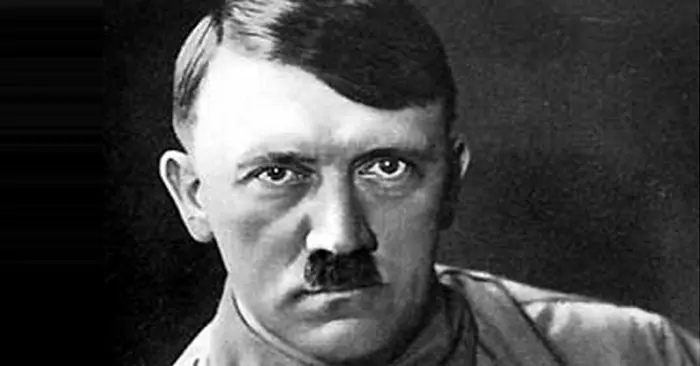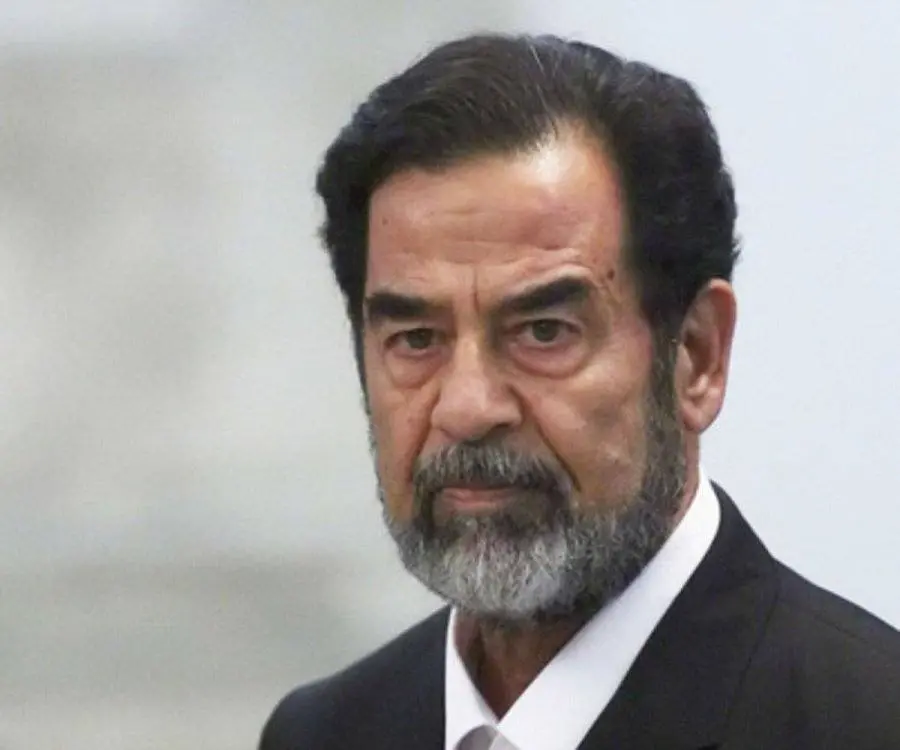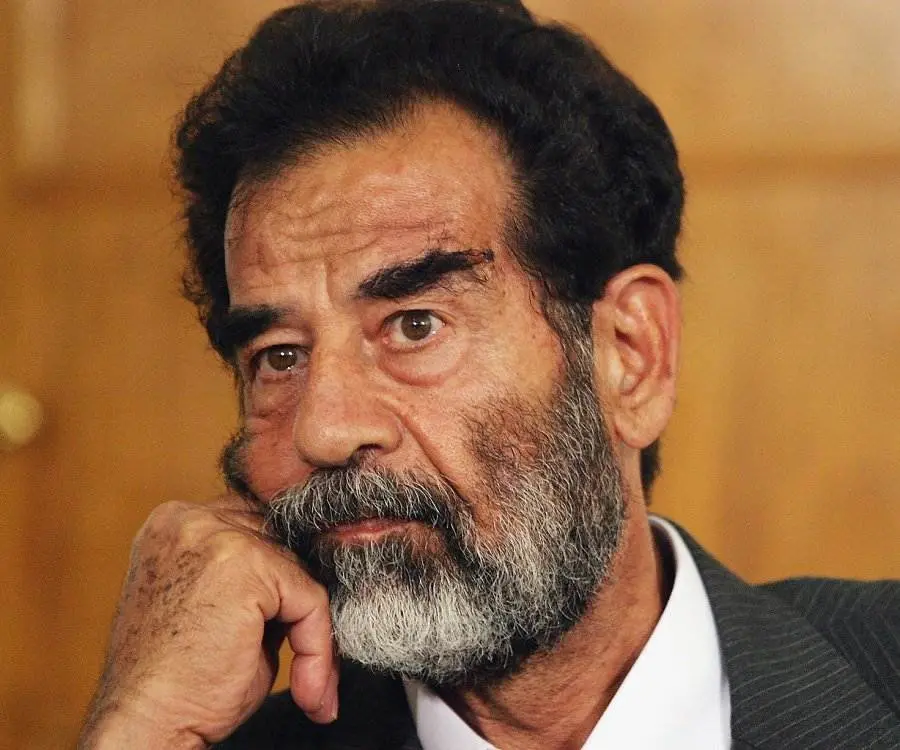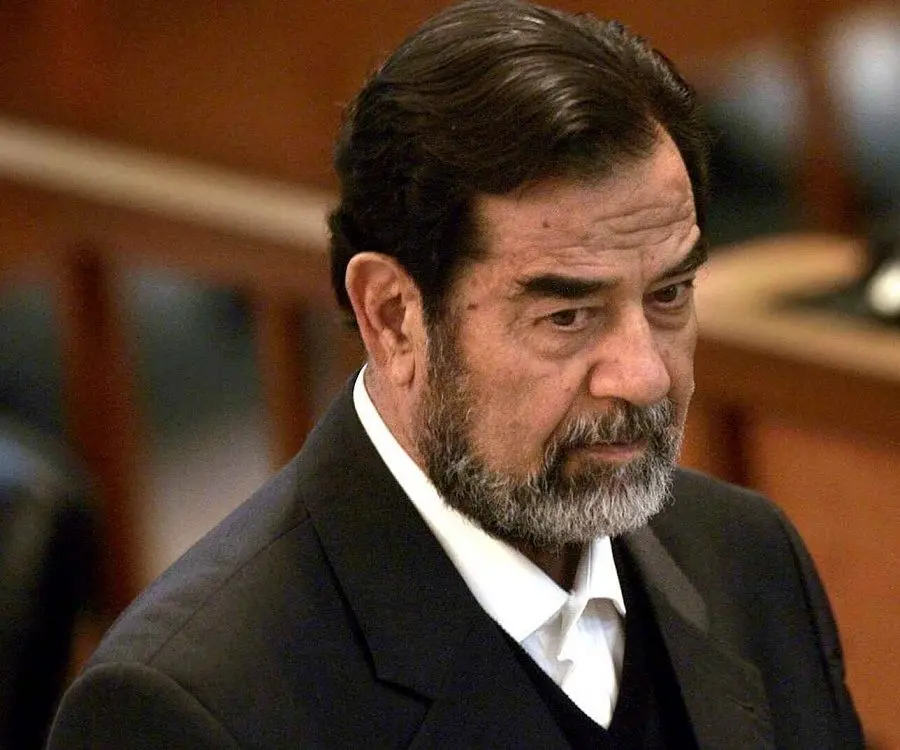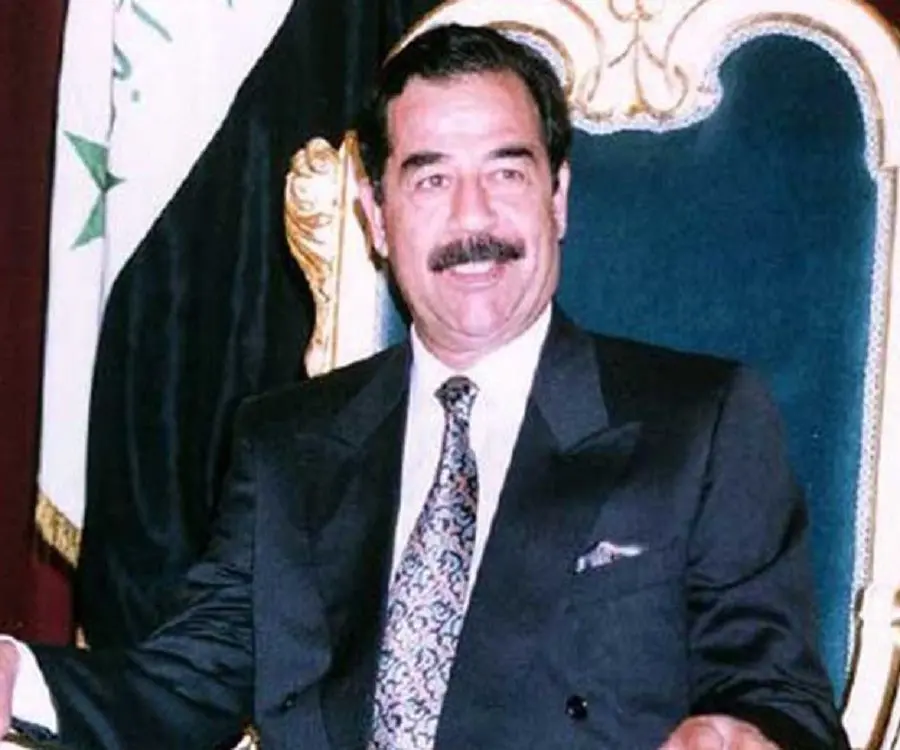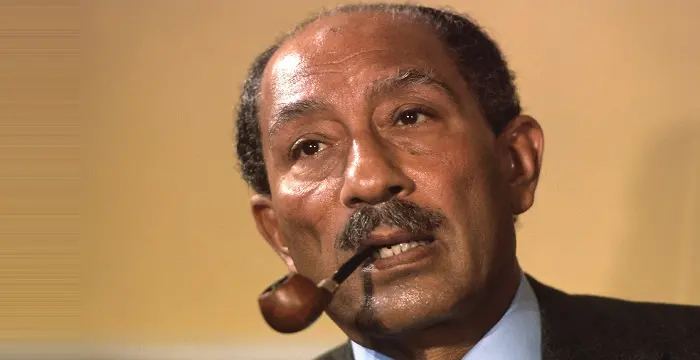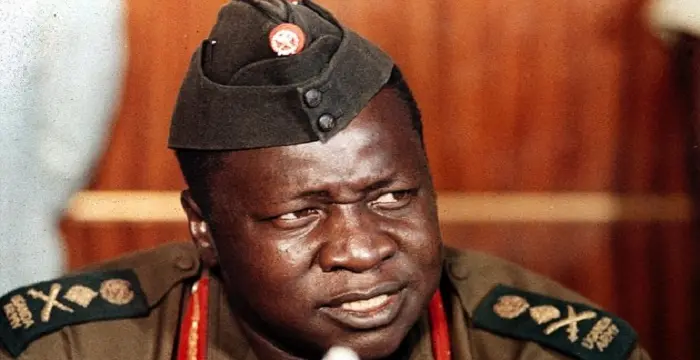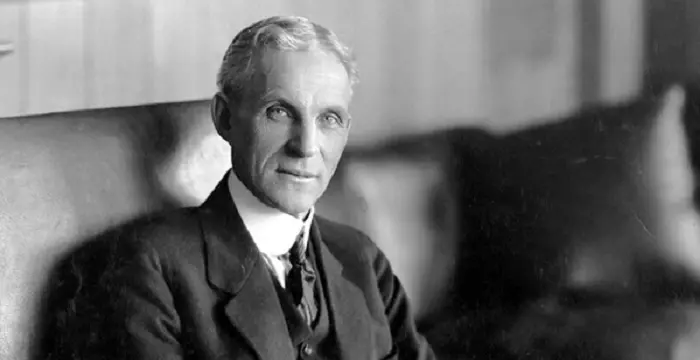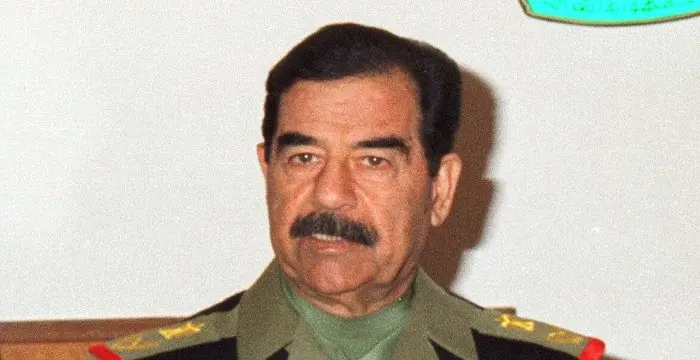
Saddam Hussein - Dictators, Life Achievements and Facts
Saddam Hussein's Personal Details
Saddam Hussein was the fifth President of Iraq whose regime lasted for nearly two and a half decades
| Information | Detail |
|---|---|
| Birthday | April 28, 1937 |
| Died on | December 30, 2006 |
| Nationality | Iraqi |
| Famous | Leaders, Political Leaders, Presidents, Dictators, ESTJ, Dictators, President of Iraq |
| Spouses | Sajida Talfah |
| Siblings | Awad Hamed al-Bandar, Barzan Ibrahim |
| Childrens | Uday Hussein |
| Universities |
|
| Cause of death |
|
| Birth Place | Al-Awja |
| Political Ideology | Arab Socialist Ba'ath Party (1957–1966), Baghdad-based Ba'ath Party (1966–2006) (NPF) |
| Religion | Sunni Islam |
| Gender | Male |
| Father | S |
| Mother | Subha Tulfah al-Mussallat |
| Sun Sign | Taurus |
| Born in | Al-Awja |
| Famous as | Dictator & President of Iraq |
| Died at Age | 69 |
// Famous Dictators
Adolf Hitler
Adolf Hitler was the infamous dictator of Germany who carried out the genocide of Jews and was majorly responsible for the World War II. Know more about his life in this biography.
Saddam Hussein's photo
Who is Saddam Hussein?
When Saddam Hussein took over as the fifth President of Iraq, hardly did the world realize that an era of strife, war and communal violence awaited the entire Middle-East. With the power vested in him, he showed Iraq the vision of a future which, if fulfilled, would have been a reality much envied even by the prosperous West. Indeed, within the first few decades of his reign, Iraq was on a road to such glory that it had not seen in ages. It is often stated that the country witnessed its best and worst days under him. The strategies he employed to settle what seemed like an eternal religious unrest in Iraq were beyond praise and he won great appreciation from both his countrymen and around the world. Illiteracy, unemployment and poverty were long forgotten words during his regime and Iraq’s evolution was on a fast-track. Saddam also basked in the splendor of the economic, social and industrial expansion of his country until the outbreak of the Iraq-Iran war. The days of glory were short lived and soon, owing to never ending conflicts and battles with the neighboring countries, and later with the West, the country was reduced to a barren land.
Childhood & Early Life
Born into a family of shepherds as Saddam Hussein Abd al-Majid al-Tikriti, this famous dictator was named ‘Saddam’ by his mother, which, in Arabic, means the ‘one who confronts’.
He was only six months old when his father abandoned the family, leaving him solely to the care of his mother. To add to the family’s misery, his teenage brother died of cancer following which, he was sent to the care of his maternal uncle Khairallah Talfah, where he stayed till he was three.
Soon his mother remarried and the toddler was sent back to stay with her. However, upset with the constant ill-treatment at the hands of his stepfather, Saddam, aged ten, fled to Baghdad to stay with his uncle again.
Introduction To Ba'ath Party
In Baghdad, he attended the al-Karh Secondary School and later dropped out. Soon he was introduced to the Ba’ath Party which derives its name from Ba’athism, an Arab nationalist ideology advocating creation of single-party states to end the political pluralism prevalent in the Arabian countries. He was deeply influenced by this ideology and became an active member of the party in 1957.
In 1958, Faisal II, the last king of Iraq, was overthrown by an army led by General Abd al-Karim Qasim, a Ba’athist, in what is known as the 14 July Revolution.
Iraq was declared a republic and Qasim became its Prime Minister who, despite being a Ba’athist, opposed the idea of Iraq joining the United Arab Republic. His alliance with the Iraqi Communist Party earned him the resentment of the Ba’ath Party and prompted other party members to act against him.
A plan to assassinate the prime minister was formulated and Saddam was asked to lead the operation. On October 7, 1959, in a bid to slay Qasim, the group started shooting but, due to a serious misjudgment on their part, the prime minister was only wounded. The assassins however assumed that Qasim was dead and fled the spot.
After the failure of the plot, fearing arrest Saddam Hussein fled to Syria where he was offered asylum by Michel Aflaq, one of the co-founders of Ba’athism. Aflaq, impressed by his dedication to Ba’athism, later made him one of the leaders of the Ba’ath party in Iraq.
In 1963, Qasim was ousted by the members of Free Officers of Iraq, an undercover militant organization, with the help of the Ba’athists. Abdul Salam Arif, a member of Free Officers of Iraq, became the president and appointed a number of Ba’ath leaders into his newly formed cabinet. Saddam, along with some other exiled leaders, returned to Iraq with hopes for a better future but to their surprise, Arif sacked all the Ba’athist leaders from his cabinet and ordered for their arrest.
In 1966, while still in prison, Saddam was appointed the Deputy Secretary of the Regional Command of the Ba’ath Party. He escaped from prison in 1967 and resolved to reorganize and revive his party and strengthen its stance in Iraq.
Rise To Prominence
The year 1968 proved to be fruitful for him as, in a bloodless coup by his party, the-then president Abdul Rahman Arif was overthrown and Ba’athist leader Ahmed Hassan al-Bakr became the new president with Saddam as his deputy.
Though al-Bakr was the president, it was the deputy who really wielded the power at the center and introduced himself as a revolutionary leader of Iraq, addressing the nation’s major domestic issues while working towards its progress.
Saddam’s political strategies were largely driven by his desire to stabilize his country which was then plagued with a multitude of internal conflicts. In tandem with this desire, he, unlike his orthodox predecessors, encouraged modernization of Iraq and began reviving the infrastructure, industry and health-care system.
Iraq flourished under this new system, the standard of living of Iraqis improved and the social services system became so strong that the neighboring countries’ socio-economic indices were overshadowed by leaps and bounds.
His initiatives, "National Campaign for the Eradication of Illiteracy" and "Compulsory Free Education in Iraq", led thousands of children to attend schools which improved the literacy rate of the country drastically.
In a series of unprecedented progressive reforms in Iraq, the families of soldiers began to be seen as national responsibilities and were extended financial support. Hospitalisation was made free for all and agriculture was promoted by way of grants to farmers.
One of his major reform initiatives included the nationalization of Iraq's oil industry just before the energy crisis of 1973, which generated huge revenues for the nation. Around this time, he facilitated the development of Iraq’s first chemical weaponry system and installed sophisticated security systems to ward off further coups.
Ascendance To Presidency & The Iran-Iraq War
In 1979, President al-Bakr began his initiatives to unite Iraq and Syria, which would have made the Syrian President Hafez al-Assad the deputy leader of the new government. This move was obviously seen as a threat by Saddam as Assad’s popularity would have overshadowed him.
He pressured al-Bakr to resign and declared himself the new president, calling off the plans for the unification. After taking over as the cabinet head, he summoned an assembly in which the names of 68 people, allegedly his political foes, were read out loud and all were tried and found guilty of treason. While only 22 of them were given death sentences, by early 1979 most of his adversaries had been executed.
The same year, an Islamic revolution led by Ayatollah Khomeini in Iran, was beginning to penetrate into Iraq. This dictator, whose power and stability rested mostly on the minority Sunni population of his country, grew anxious as the uprising profoundly influenced the Shi-ite Iran and the risks of a similar revolt in Iraq escalated.
To avoid any internal rebellions in Iraq, he sent his armed forces to conquer the oil-rich region of Khuzestan in Iran on 22 September 1980. This move was the final straw for the neighboring Iran and what could have remained only as a conflict, took a turn for worse and a war broke out between the two neighboring nations.
Europe and the US, along with the Arab states of the Persian Gulf, overlooked his ruthless use of weapons of mass destruction during the war, which claimed the lives of thousands of civilians. Basically, all these nations feared the spread of Islamic fanaticism in Arab and therefore, pinned all their hopes on his modernistic outlook.
Finally, on August 20, 1988, after the war had wrecked a massive devastation on both the sides and killed at least a million people, a ceasefire was called for and the war was put to an end.
The war had taken a huge toll on Iraq’s economy and infrastructure, which demanded immediate attention of the government and the country was confronted with the task of rebuilding itself. The president desperately looked for ways of regaining his socio-economic supremacy in the region.
His first move was approaching the wealthy and flourishing state of Kuwait, to get a debt of $30 million, borrowed during the war, pardoned. Later however, Kuwait’s refusal to raise the exporting oil prices on Iraq’s insistence led to tensions between the two countries.
Frustrated by Kuwait’s insubordination and desperate for immediate financial revival of his country, Saddam cornered Kuwait claiming that it was historically a part of Iraq and even had oil reserves within its disputed boundaries. Later, using the same premise, he invaded this oil rich nation on August 2, 1990.
Invasion of Kuwait
On 28 August 1990, Kuwait was annexed to Iraq and was declared the 19th province of Governorate of Iraq. His invasion of Kuwait was harshly condemned by the Gulf nations and almost all of them turned against him.
The United States was also against this move and collaborated with the UN to pass a resolution in August 1990, which ordered the evacuation of Iraqi army from Kuwait by January 1991.
It was this belligerent dictator’s open defiance of this resolution which led U.S to send its forces to drive the Iraqi troops out of Kuwait in February 1991.
A ceasefire agreement followed and Iraq was asked to surrender and dismantle its chemical weaponry. Despite an embarrassing defeat, the Iraqi president blatantly claimed his victory in the Gulf conflict.
Internal Conflicts
The Gulf War worsened the economic condition of Iraq and fuelled the already existing struggles, such as Shi’as vs. Sunnis and Arabs vs. Kurds, triggering several upheavals.
Rebellions flared up in many parts of Iraq, primarily in the northern part where Kurds formed a majority of the population, and the southern regions which had a Shi’a majority. Angry and frustrated revolutionaries swore to end the dictatorial reign which put the president’s position at stake.
These uprisings were propelled by the U.S which had instigated the Iraqis to rise against their president, but when he deployed his security forces to repress the rebellions, the U.S. did nothing to support the revolutionaries. The uprisings were highly disorganized and the armed forces did not have much difficulty in crushing them.
Saddam, who had already claimed victory in the Gulf War, now referred to the defeat of the rebellions as a ‘proof’ of his victory against the U.S. Many Arab factions were impressed by his victory and extended their support. All of them saw U.S. as their common enemy and despised foreign intervention in their internal matters.
To appease the orthodox Muslim factions, he portrayed himself as a devout Muslim and began cooperating with them. He even ordered a ‘Blood Qur’an’, to be written in his own blood, to express his gratitude to God for rescuing him and his countrymen from such bad times.
In 1993, his troops continually violated the ‘no-fly zone’ enforced after the Gulf War. The U.S. soon retorted and bombed Iraq's intelligence headquarters in Baghdad on 26 June 1993. After a brief period of compliance, Iraq violated the no-fly zone yet again in 1998 to the ire of the US.
US also accused Iraq of continuing its weapons programs and launched a series of missile attacks on Baghdad which continued till February 2001.
Later, in September 2001, when the twin tower attacks occurred, U.S claimed that Saddam Hussein and al-Qaeda were jointly involved in the act. Consequently, Bush administration declared ‘War on Terror’ and the US troops invaded Iraq in 2003.
Iraq Invasion & Fall of Saddam (Seizure, Trial & Execution)
On 20 March 2003, after intermittent attacks, the U.S. captured most of Iraq and ordered the arrest of Saddam. He went underground but kept releasing audio tapes disparaging the U.S. invasion. Meanwhile, his sons Uday and Qusay, and his 14-year-old grandson Mustapha were killed in an encounter with the U.S. troops, in July 2003.
Finally, on 13 December 2003, his whereabouts were successfully tracked and he was captured near a farmhouse in ad-Dawr, hiding in a small trench. He was shifted to the U.S. base in Baghdad where he remained till June 30, 2004, before being handed over to the temporary Iraqi government for trial.
After being found guilty of several crimes against humanity, this former Iraqi president was sentenced to death on November 5, 2006. He was hanged on 30 December 2006, first day of Eid ul-Adha, against his wish to be shot, which according to him was a more honorable way of dying.
Personal Life
His first wife, Sajida Talfah, was his cousin whom he married in 1958. She was the daughter of his maternal uncle Khairallah Talfah. He fathered five children with her viz., Uday Hussein, Qusay Hussein, Raghad Hussein, Rana Hussein and Hala Hussein.
His second wife was Samira Shahbandar, whom he married in 1986. Before their marriage, Shahbandar was married to an Iraqi Airways executive but stayed with the dictator as his mistress. Later, Saddam forced Shahbandar’s husband to divorce her so that they could marry.
Nidal al-Hamdani, the general manager of the Solar Energy Research Center in the Council of Scientific Research, was his third wife. It was also rumored that he got married for a fourth time to Wafa el-Mullah al-Howeish in 2002.
Trivia
Since he was condemned by the Arab world as ‘unIslamic’, this former president embraced Islam publicly in 1999 to prove his devotion to the religion. He also claimed to be the direct descendent of Prophet Muhammad.
The ‘Blood Qur’an’ was commissioned by this dictator in 1997 for which he donated several liters of his own blood over a course of two years.
This famous dictator possessed a huge collection of weapons made of gold.
// Famous Presidents
Khalifa bin Zayed Al Nahyan
Sheikh Khalifa bin Zayed Al Nahyan is the current President of the United Arab Emirates (UAE). Check out this biography to know about his birthday, childhood, family life, achievements and fun facts about him.
Anwar Sadat
Anwar Sadat was the third President of Egypt and has been awarded the Nobel Prize for his peace initiatives. To know more about his childhood, career, profile and timeline read on the following biography.
Idi Amin
A Ugandan dictator, Idi Amin is remembered for his brutal regime and crime against humanity. Check this biography to know in details about his life, childhood, profile and timeline.
Saddam Hussein biography timelines
- // 1957In Baghdad, he attended the al-Karh Secondary School and later dropped out. Soon he was introduced to the Ba’ath Party which derives its name from Ba’athism, an Arab nationalist ideology advocating creation of single-party states to end the political pluralism prevalent in the Arabian countries. He was deeply influenced by this ideology and became an active member of the party in 1957.
- // 1958In 1958, Faisal II, the last king of Iraq, was overthrown by an army led by General Abd al-Karim Qasim, a Ba’athist, in what is known as the 14 July Revolution.
- // 1958His first wife, Sajida Talfah, was his cousin whom he married in 1958. She was the daughter of his maternal uncle Khairallah Talfah. He fathered five children with her viz., Uday Hussein, Qusay Hussein, Raghad Hussein, Rana Hussein and Hala Hussein.
- // 1959A plan to assassinate the prime minister was formulated and Saddam was asked to lead the operation. On October 7, 1959, in a bid to slay Qasim, the group started shooting but, due to a serious misjudgment on their part, the prime minister was only wounded. The assassins however assumed that Qasim was dead and fled the spot.
- // 1963In 1963, Qasim was ousted by the members of Free Officers of Iraq, an undercover militant organization, with the help of the Ba’athists. Abdul Salam Arif, a member of Free Officers of Iraq, became the president and appointed a number of Ba’ath leaders into his newly formed cabinet. Saddam, along with some other exiled leaders, returned to Iraq with hopes for a better future but to their surprise, Arif sacked all the Ba’athist leaders from his cabinet and ordered for their arrest.
- // 1966In 1966, while still in prison, Saddam was appointed the Deputy Secretary of the Regional Command of the Ba’ath Party. He escaped from prison in 1967 and resolved to reorganize and revive his party and strengthen its stance in Iraq.
- // 1968The year 1968 proved to be fruitful for him as, in a bloodless coup by his party, the-then president Abdul Rahman Arif was overthrown and Ba’athist leader Ahmed Hassan al-Bakr became the new president with Saddam as his deputy.
- // 1973One of his major reform initiatives included the nationalization of Iraq's oil industry just before the energy crisis of 1973, which generated huge revenues for the nation. Around this time, he facilitated the development of Iraq’s first chemical weaponry system and installed sophisticated security systems to ward off further coups.
- // 1979In 1979, President al-Bakr began his initiatives to unite Iraq and Syria, which would have made the Syrian President Hafez al-Assad the deputy leader of the new government. This move was obviously seen as a threat by Saddam as Assad’s popularity would have overshadowed him.
- // 1980To avoid any internal rebellions in Iraq, he sent his armed forces to conquer the oil-rich region of Khuzestan in Iran on 22 September 1980. This move was the final straw for the neighboring Iran and what could have remained only as a conflict, took a turn for worse and a war broke out between the two neighboring nations.
- // 1986His second wife was Samira Shahbandar, whom he married in 1986. Before their marriage, Shahbandar was married to an Iraqi Airways executive but stayed with the dictator as his mistress. Later, Saddam forced Shahbandar’s husband to divorce her so that they could marry.
- // 1988Finally, on August 20, 1988, after the war had wrecked a massive devastation on both the sides and killed at least a million people, a ceasefire was called for and the war was put to an end.
- // 2nd Aug 1990Frustrated by Kuwait’s insubordination and desperate for immediate financial revival of his country, Saddam cornered Kuwait claiming that it was historically a part of Iraq and even had oil reserves within its disputed boundaries. Later, using the same premise, he invaded this oil rich nation on August 2, 1990.
- // 28th Aug 1990On 28 August 1990, Kuwait was annexed to Iraq and was declared the 19th province of Governorate of Iraq. His invasion of Kuwait was harshly condemned by the Gulf nations and almost all of them turned against him.
- // Feb 1991It was this belligerent dictator’s open defiance of this resolution which led U.S to send its forces to drive the Iraqi troops out of Kuwait in February 1991.
- // 1993In 1993, his troops continually violated the ‘no-fly zone’ enforced after the Gulf War. The U.S. soon retorted and bombed Iraq's intelligence headquarters in Baghdad on 26 June 1993. After a brief period of compliance, Iraq violated the no-fly zone yet again in 1998 to the ire of the US.
- // Feb 2001US also accused Iraq of continuing its weapons programs and launched a series of missile attacks on Baghdad which continued till February 2001.
- // 2003Later, in September 2001, when the twin tower attacks occurred, U.S claimed that Saddam Hussein and al-Qaeda were jointly involved in the act. Consequently, Bush administration declared ‘War on Terror’ and the US troops invaded Iraq in 2003.
- // Mar 2003On 20 March 2003, after intermittent attacks, the U.S. captured most of Iraq and ordered the arrest of Saddam. He went underground but kept releasing audio tapes disparaging the U.S. invasion. Meanwhile, his sons Uday and Qusay, and his 14-year-old grandson Mustapha were killed in an encounter with the U.S. troops, in July 2003.
- // 13th Dec 2003Finally, on 13 December 2003, his whereabouts were successfully tracked and he was captured near a farmhouse in ad-Dawr, hiding in a small trench. He was shifted to the U.S. base in Baghdad where he remained till June 30, 2004, before being handed over to the temporary Iraqi government for trial.
- // 30th Dec 2006After being found guilty of several crimes against humanity, this former Iraqi president was sentenced to death on November 5, 2006. He was hanged on 30 December 2006, first day of Eid ul-Adha, against his wish to be shot, which according to him was a more honorable way of dying.
// Famous ESTJ
Bette Davis
Bette Davis was an acclaimed American actress. Check out this biography to know about her childhood, life, achievements, works & timeline
Lucy Liu
Lucy Alexis Liu is an American actress, model and an occasional film producer. This biography profiles her childhood, early life, career, major works, awards, achievements, personal life, legacy and timeline.
Emma Watson
Emma Watson is a British actress and model, best-known for her role as ‘Hermione Granger’ in the Harry Potter series. Explore this biography to learn more about her profile, childhood, life and timeline.
Megyn Kelly
Megyn Kelly is an American journalist, political commentator and former corporate defense attorney. Check out this biography to know about her childhood, family life, achievements and fun facts about her life.
Uma Thurman
Uma Thurman is an award winning American actress best known for her work in ‘Pulp Fiction’ and the ‘Kill Bill’ films. This biography of Uma Thurman provides detailed information about her childhood, life, achievements, works & timeline.
Henry Ford
Henry Ford was the founder of the Ford Motors Company, had brought a revolution in the automobile industry. This biography of Henry Ford provides detailed information about his childhood, life, achievements, works & timeline.
Saddam Hussein's FAQ
What is Saddam Hussein birthday?
Saddam Hussein was born at 1937-04-28
When was Saddam Hussein died?
Saddam Hussein was died at 2006-12-30
Where was Saddam Hussein died?
Saddam Hussein was died in Kadhimiya
Which age was Saddam Hussein died?
Saddam Hussein was died at age 69
Where is Saddam Hussein's birth place?
Saddam Hussein was born in Al-Awja
What is Saddam Hussein nationalities?
Saddam Hussein's nationalities is Iraqi
Who is Saddam Hussein spouses?
Saddam Hussein's spouses is Sajida Talfah
Who is Saddam Hussein siblings?
Saddam Hussein's siblings is Awad Hamed al-Bandar, Barzan Ibrahim
Who is Saddam Hussein childrens?
Saddam Hussein's childrens is Uday Hussein
What was Saddam Hussein universities?
Saddam Hussein studied at nationalistic high school in Baghdad
What is Saddam Hussein's cause of dead?
Saddam Hussein dead because of Execution
What is Saddam Hussein's political ideology?
Saddam Hussein's political ideology is Arab Socialist Ba'ath Party (1957–1966), Baghdad-based Ba'ath Party (1966–2006) (NPF)
What is Saddam Hussein's religion?
Saddam Hussein's religion is Sunni Islam
Who is Saddam Hussein's father?
Saddam Hussein's father is S
Who is Saddam Hussein's mother?
Saddam Hussein's mother is Subha Tulfah al-Mussallat
What is Saddam Hussein's sun sign?
Saddam Hussein is Taurus
How famous is Saddam Hussein?
Saddam Hussein is famouse as Dictator & President of Iraq
